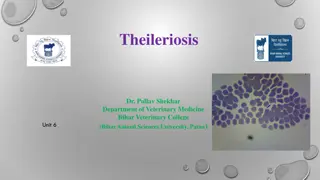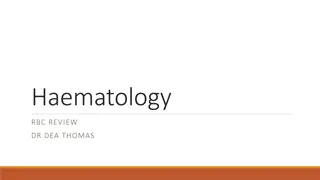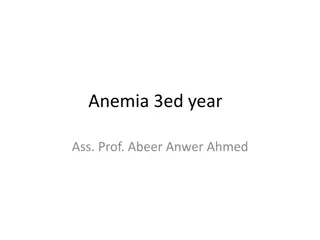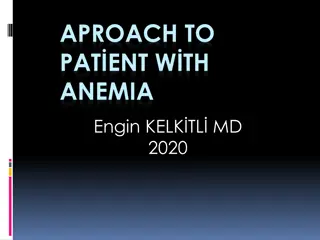Understanding Anemia: Causes, Types, and Impact on Indian Population
Anemia is a serious health condition characterized by low hemoglobin levels, leading to reduced oxygen supply to the body. This article delves into the definition of anemia, its types - including genetic and nutritional anemia, and highlights the significant prevalence of anemia in India, especially among women and children. The data presented underscores the urgent need for addressing nutritional deficiencies to combat this silent killer.
Download Presentation

Please find below an Image/Link to download the presentation.
The content on the website is provided AS IS for your information and personal use only. It may not be sold, licensed, or shared on other websites without obtaining consent from the author. Download presentation by click this link. If you encounter any issues during the download, it is possible that the publisher has removed the file from their server.
E N D
Presentation Transcript
Anemia a silent killer Anemia a silent killer Organic Kitchen Garden for Nutrition A Sustainable Solution
What is Anemia ? What is Anemia ? Anemia means lower haemoglobin (Hb) level in the Red Blood Cells than the normal range. Hb acts as an oxygen carrier and is a deciding factor for transporting oxygen (O2) from lungs to cells. The concentration of Hb in Red Blood Cells is the deciding factor as to how much O2 is carried by the blood. If O2 carrying capacity of blood is decreased, it leads to less supply of oxygen to the brain and other parts of the body. This results in less energy production, weakness, easy fatigability, low immunity, more susceptibility to infections.
Anemia types Anemia types There are over 400 types of anemia divided into two major categories 1. Anemia due to genetic inheritance Sickle Cell Anemia 2. Nutritional anemia (Mild and Moderate anemia) Nutritional anemia is due to deficiency in nutrition consumed or absorbed in the body. An estimated 80 to 85% of anemia is in the Mild and Moderate in India and is due to nutrition deficiency i.e. inadequate, poor quality and/or imbalanced food intake.
Anemia in over 40% of population is serious (WHO) : Indias Anemia Status 90% Source : National Health Family Survey - 4 80% 70% 60% 50% 40% 30% 20% 10% 0% Kerala Sikkim Jharkhand Mizoram Himachal Pradesh Chandigrh Odisha Nagaland Goa NCT Delhi Uttar Pradesh Uttarakhanda Chhattisgarh Jammu & Kashmir Hariyana Arunachal Pradesh Panjab Andhra Pradesh Tamil Nadu Tripura Bihar Karnataka Meghalaya Daman & Div Manipur Rajasthan Lakshadweep Aasam Dadra Nagar Haveli Maharashtra Punducherry Telengana Madhya Pradesh Gujrat West Bengal Andaman Nikobar Men (15 to 49 Yrs) Women (15 to 49 Yrs ) Children (6 to 49 Months )
Indian Women :Anaemia % in Indian Women aged 15 to 49 years is Serious 100% 90% 53% women are suffering from Anaemia on an average (NHFS -4 ) 80% 70% 60% 50% 40% 30% 20% 10% 0% Goa Kerala Sikkim Mizoram NCT Delhi Chandigrh Hariyana Arunachal Pradesh Odisha Jammu & Kashmir Himachal Pradesh Uttar Pradesh Chhattisgarh Nagaland Jharkhand Uttarakhanda Telengana Maharashtra Bihar Tripura Rajasthan Karnataka Gujrat Panjab Lakshadweep Aasam Manipur Andaman Nikobar Punducherry Andhra Pradesh Tamil Nadu Dadra Nagar Haveli Daman & Div Meghalaya Madhya Pradesh West Bengal Source : National Health Family Survey - 4 Women Age 15 -49 HB < 13
India :Anaemia percentage in Indian Children 0 to 59 months is Very Serious 90% 58.5 % children below 5 years are suffering from Anemia ( NHFS -4 ) 80% 70% 60% 50% 40% 30% 20% 10% 0% Odisha Kerala Hariyana Sikkim NCT Delhi Mizoram Chandigrh Himachal Pradesh Goa Arunachal Pradesh Jammu & Kashmir Uttar Pradesh Chhattisgarh Nagaland Jharkhand Uttarakhanda Madhya Pradesh Bihar Karnataka Telengana Rajasthan Tripura Gujrat Panjab Lakshadweep Maharashtra Aasam Manipur Andaman Nikobar Punducherry Andhra Pradesh Tamil Nadu Meghalaya Dadra Nagar Haveli Daman & Div West Bengal Source : National Health Family Survey - 4 Children (6 to 59 Months )
Impact of Anemia Impact of Anemia Anemia in more than 40% of the population is considered a serious health problem by the World Health Organization (WHO) 2016 Global Burden of Disease (GBD) survey ranked iron- deficiency as the top factor for disability in India. Anemia has led to 17% loss in productivity among workers engaged in heavy physical labour and a 5% dip in the output of moderately active workers, besides causing cognitive deficits upto 4% in malnourished children, according to this 2002 study published in the Journal of Nutrition. India loses 0.9% of its gross domestic product (GDP) due to iron-deficiency anaemia, according to a 2003 paper published in Food Policy. This could mean a loss of up to $20.25 billion (Rs.1.35 lakh crore), according to the World Bank s estimate of India s GDP in 2016.
Short term and long term Impact Short term and long term Impact Short-term impact Mortality Morbidity Disability Long-term impact Stunting, Cognitive ability reduces Economic productivity reduces Reproductive performance poorer Metabolic and cardiovascular diseases increase
Impact of Anemia on Children and Adolescent girls Impact of Anemia on Children and Adolescent girls Depressed Cognition Inferior school performance Reduced future earnings & productivity Depressed immunity Repeated infections Estimated to cause IQ reduction of 5 to 10 points
Impact of Anemia on Adolescent girls and Impact of Anemia on Adolescent girls and Women, Women, Foetus Foetus and Infants and Infants Possibility of irregularity in menstrual cycle in adolescent girls. Possibility of high risk mothers in future IN WOMEN MATERNAL MORTALITY - 20% DIRECTLY A RESULT OF ANEMIA. ANOTHER 20 TO 30% MORTALITY IS CAUSED INDIRECTLY BY ANEMIA. ANEMIA DURING PREGNANCY MAY LEAD TO FOETAL DEATHS. ANEMIA MAY LEAD TO PREMATURE AND UNDERWEIGHT BABIES. POSSIBILITY OF ABNORMALITIES IN THE NEW BORN.
ORGANIC KITCHEN GARDEN FOR NUTRITION (OKGN) ORGANIC KITCHEN GARDEN FOR NUTRITION (OKGN)
Organic Kitchen Gardens dramatically improved Hb Initial status in % Status after kitchen garden in % 100 100 100 Percentage of Women with Normal Hemoglobin 90.32 90 80 71 70 59 60 50 40.62 36 40 35.7 35 35 32.5 31.4 30 20 14 12.5 7.3 10 5.8 0 Jamni Amgaon Antargaon Hiwara Nanbardi Malegaon (Theka) Mhsala Charmandal 1 2 3 4 5 6 7 8 Kitchen Garden Project in Vidharba by NOCW, supported by Rotary Club of Bombay & The Sahayak Trust (2010-13)
ORGANIC KITCHEN GARDENS FOR NUTRITION ORGANIC KITCHEN GARDENS FOR NUTRITION A Sustainable Solution A Sustainable Solution Easier to develop in Rural areas since already a cultural habit. Very less investment (< Rs 200 per year). Consistent and enough supply for at least 8 months in the year. Saves approx. Rs. 300 to 800 per month per family for buying vegetables. Non toxic vegetables - free of pesticides and chemicals. Improves health and immunity; saves medical expenses Prevents lifelong damage to child s growth (body & mind development)
Anemia Free India Forum Anemia Free India Forum Anemia Free India Forum (AFIF) is a network of organizations across India who share the vision of making India anemia free. AFIF is a common platform for sharing ideas and co-ordinating action . AFIF aims to make India Free of Nutritional Anemia OKGN is a simple and sustainable solution for Nutritional Anemia The Sahayak Trust, as the Knowledge and Training Partner of AFIF, assists Implementing Partners by playing the role of: Catalyst -by providing training to trainers, Facilitator - helping to solve problems Co-ordinator -collecting, analyzing and disseminating information
Principles of AFIF Principles of AFIF 1. Create awareness of Anemia 2. Help develop OKGNs having diversity 3. Get OKGNs grown organically without chemicals 4. Ensure OKGNs are firstly for family consumption 5. Monitor Hb levels of participants & share data. 6. Encourage family and community involvement by behavioural changes in community (BCC)























